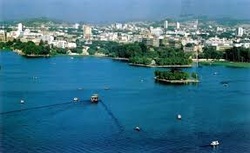 Jinan, the capital of Shandong Province, is located in the midwest of Shandong and acts as a traffic junction to many worthwhile attractions in the province. Known as the 'City of Springs', it is popular among visitors for its many springs and unique manly Lu Culture. Jinan is a historical city with a history of some 2,000 years and is famed for its numerous relics. It is the cradle of the Longshan Relics Culture, the reputed prehistoric culture of China and is found in Longshan Town, hence the name. Here you will find far more than you would expect, the ancient Great Wall of the Qi State (a state of the Zhou Dynasty (770B.C. – 221B.C.)), the colored sculptures of the Song Dynasty (960-1279) in the Lingyan Temple and so on. The city is the home of Shandong cuisine, a popular cuisine of China. The unique souvenirs include Ejiao, Black Pottery, Lu Embroidery and Wooden-Fish wares. Jinan is the right place to see some very typical festivals including The Lantern Festival in the Baotu Spring Park, the Lotus Festival in the Daming Lake Park and the Double-Nine Festival on the Thousand-Buddha Mountain. In the Daming Lake ParkThe city is hospitable and receives visitors from all over the world. Marco Polo once visited it and left words of praise to this city. The Baotu Spring, Daming Lake and the Thousand Buddha Mountain decorate the city as a beautiful garden. Compared with those capital cities, or other large and medium-size cities in China, the city has few advantages and lacks a metropolitan atmosphere, the highlight being its numerous springs. Some people say Jinan's glamour is not merely its enticing natural beauty, but more the warmth of the local people. The beauty of nature is thin and weak, but the beauty that comes from people will last forever.
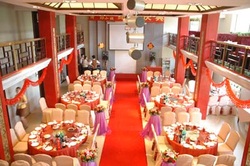 On June 6, 1996, the first Meizhou Dongpo Restaurant was established in Beijing with its signboard inscribed by Wang Guangying, vice chairman of the Standing Committee of the NPC. In 2003, the Beijing Meizhou Restaurant Management Co. Ltd. was established. Under the leadership of President Wang Gang, the employees devoted themselves to expanding the Dongpo culture and developing the brand, insisting on quality and innovation and guarding the strict quality. The enterprise developed quickly and became one of the most stable large dining enterprises in the domestic market. The dining enterprise now has: a head quarters, a distribution center, a central authority kitchen, over 20 chain restaurants and over three thousand employees in China. The company includes: Meizhou Dongpo Restaurant, Wangjiadu Chaffy Dish, Meizhou Snacks, Home-Made Specialty many other sections.
In 2000, the company was awarded an award as a "Sichuan Famous Restaurant" by the Sichuan Provincial Government. In 2002, they participated in the first Sichuan Cuisine Contest in the 12th National Chef Festival and were awarded the award of "Famous Banquet of China" and the "Team Gold Award". In the same year, the company was recognized as a "Chinese Famous Restaurant" by the China Cooking Association and President Wang Gang was given an award as a "China excellent Entrepreneur in Food and Beverage Industry". In 2003, President Wang Gang was granted an award of the "Standing Committee of the Meishan Committee of the Political Consultative Conference". That same year, Meizhou Dongpo was chosen as first in the Chinese Food and Beverage Industry by Tsinghua University School of Economics and Management. In 2005, President Wang Gang was awarded "The Excellent Carving" award and was engaged as an MBA assistant of Tsinghua University. In 2005, the company cooperated with the Hormel Company and produced Homel Meizhou Dongpo Sausage. In 2006, President Wang Gang was chosen as "The Greatest Power Person Of Beijing". In April of 2006, the company passed the standard for the ISO9000 Quality Management System. In 2007, President Wang Gang was chosen chairman on duty by FOODUN. Also in 2007, Meizhou Dongpo Restaurant was chosen as one of "Greatest Power Brands Top Ten" of Beijing and in April of 2007, the company was chosen as an advanced unit of Beijing Harmonious Labor Relations.
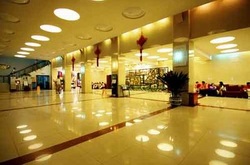 Chaoyang Theater on Dongsanhuan Road has a superior location and advanced management experiences, which enable it to be the best place for acrobatics performances. Its particular brand, Acrobatics World, has received wide recognition from many travel agencies both in and out of China. Some foreign travel agencies even make reservations two years in advance for the tickets of acrobatic performances held here. The most impressive characteristics of these acrobatics performances are beauty, thrill, surprise and inconceivability. So it is no wonder that Bora Milutinovic,the former head coach of Chinese National Football Team, Mr. Milutinovic, took his family to enjoy the acrobatics shows for four times and spoke highly of the performances by saying that "it's really marvelous here".
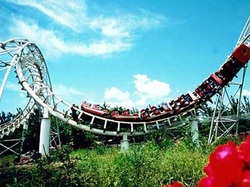 The Shijingshan Amusement Park is a State AAAA Tourist Area. It is located on the north side of the western end of Chang'an Avenue in Beijing and on the western side of the West Fifth Ring Road, 15 km from Tian'anmen Square. It is a scenic spot and theme park, integrating fitness, entertainment, appreciation of literature and art, catering and shopping. Completed in September 1986, the Shijingshan Amusement Park covers 340,000 square meters, is composed of three parts: the Entrance Zone Square, Eastern Science-fiction Theme Zone and the Western cartoon theme zone. The Entrance Zone Square is a sunken green culture square. The first level along the streets is a music fountain square, the second one contains a green lighting square covered with Chinese roses and flowers, and the third is used for cultural activity, covering 31,000 square meters. There are 71 various theme amusements. The track length of the suspended and reciprocating roller coaster totals 888 meters, ranking No. 1 in Asia; Jones Adventure heads the top in Asia for track height of 25 meters and total length of 480 meters. 4D Flying Theater boasts vertical a ball screen diameter of 22 meters; dynamic seat devices can raise the audience up to 15 meters in the air. The digital-controlled dynamics and restoration of digital camera shots enable the audience to simulate flying high in the sky.
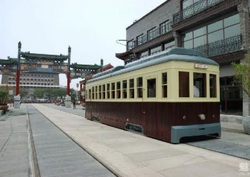 Qianmen Street is a well-known commercial street in Beijing. Located in the axis of Beijing, Qianmen Street goes from Zhengyangmen Embrasured Watchtower in the north and stretches to Tiantan (Temple of Heaven) Road in the south, which connects with Tianqiao South Street. Before the outer city was built in the 29th year of Jiajing (AD 1550) during the Ming Dynasty, Qianmen Street used to be the Royal Road for emperors to go towards the Temple of Heaven and Altar to the God of Agriculture. When the construction work of the outer city was completed, it became the main north-south artery in the outer city, called Qianmen Street by the people. This street was officially called Zhengyangmen Street during the Ming Dynasty, Qing Dynasty and the Republic of China, and was renamed as Qianmen Street in 1965. It is 1660 meters long and 20 meters wide (for carriageways).
With the urban development and building projects during the Ming and Qing dynasties, many bazaars and guild halls converged in Qianmen Street, which gradually made it evolve into a major business district focusing on shopping and entertainment. At the same time, Quanjude Peking Roast Duck-Since 1864, Bianyifang Roast Duck Restaurant, Ruifuxiang Silk-Since 1862, Tongrentang Chinese Medicine-Since 1669 and other brand shops also opened outlets here, and a century-old cultural circle has emerged as a result. In comparison with Wangfujing Pedestrian Street, Qianmen Pedestrian Street gives more prominence to the original flavor of Beijing. Qianmen Pedestrian Street consists of many functional areas such as Beijing's Culture, Domestic and Foreign Cuisines, Brand Shopping, Leisure & Fitness and so on. Nowadays, over 80 of China's Time-honored Brands along the street unfold the far-reaching cultural deposits and characteristics of historic heritages of the Qianmen Area.
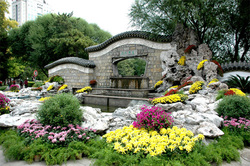 As one of the National AAA Tourism Attractions, Tuanjiehu City Park is modeled on a historic garden in South China, which covers an area of 123,000 m2, including a water area of 54,000 m2. The buildings in the park show not only the solemn of the North but also the features of the South, such as gray roofs, white walls and Nanmu color. The garden has a grassland of 36,970 m2 with 8,676 trees of various kinds, occupying 72% of the whole park. Thanks to the large variety of plants, the park remains green throughout the year.
The main attractions include Yunshan, Deyuelang, Shugehexiang, Mingyifang, Jingxiangting, Wanxiayixiuting, Liushuizhaobi, Lancuixuan and the Simulated Beach. The park is well designed with pavilions, corridors, towers, walls, bridges, boats and halls. The three bridges named “Huanbo”, “Jiexiu” and “Yinsheng”are beautifully and uniquely built. Minyifang, Deyuelang and Banbichanglang reveal the sense of traditional local architecture.
 Hefei Exhibition Park of the 9th China (Beijing) International Garden Expo (hereinafter referred to as "Tianjin Exhibition Garden") is located in the Modern Exhibition Garden, adjacent to Urumqi Exhibition Park and Tangshan Exhibition Park. Hefei Exhibition Park is full of green plants, and stream in the garden flows around Lotus Square, murmuring stream leading tourists to the depth of Garden for exploring its "secret".
Overall Bird`s Eye View
—Green Symphony, flourishing garden, garden city, beautiful homes--
"The endless drizzle wet spring mud, often hear water flowing and birds crowing separated by the fog. Willow hides a smile and peach is with smile, pass with a whip and see a boy is drawing at west of the bridge."
Hefei Exhibition Park opens with a poem-Spring Dawn of South Lake of Wang Tongwen from Qing Dynasty, "The endless drizzle wet spring mud, often hear water flowing and birds crowing separated by the fog. Willow hides a smile and peach is with smile, pass with a whip and see a boy is drawing at west of the bridge." It reflects honesty and integrity of Justice Bao with lotus with a sharp sense of integrity, and brings "Justice Bao spirit" of promoting honesty and upright to the world with the carrier "Justice Bao".
Exhibition Park adopts characteristics of Huizhou Architecture in Xidihong Village, and tourists can see archaizing memorial archway, Chaohu Lake, painting bridge, Justice Bao Culture Exhibition Area and Lianquan Scenic Spot, and Justice Bao Culture Exhibition Area forms a capital of "Combination" with Lotus Square, Justice Bao Sculpture and arced landscape pavilion, and shows welcome to friends from various regions by lotus- symbol and emissary of friendship.
 The 9th China International Garden Expo, which opened in Beijing's Fengtai District last Saturday, offers a place where citizens and tourists alike can see miniature replicas of famous buildings from China and around the world on the 500-hectare expo site. Regular cultural activities such as a parade of floats, music and stunt performances are scheduled during the six-month-long event.
 Located in northwest of Enshi City, central China's Hubei province, the Enshi Tusi Imperial City covers an area of more than 300 mu (one mu equals to 0.0667 hectare). The City is built on a mountain slope, with streams running through, and dotted with green pines and bamboos. Built by local artisans, it's a manor architectural complex, modeled after an antique Tusi city in Tujia area.
The Enshi Tusi Imperial City was opened to the public in 2002. There are three main scenic areas: ethnic culture exhibition area, religion exhibition area, and leisure and recreation area. The city is the only landmark construction of Tusi culture in Tujia area with the largest and the most magnificent scale, the most unique style, and the most beautiful scenery. There are traditional architectures of Tujia, Miao and Dong ethnic groups, showing architectures and sculptures of various styles.
Tujia "Jiujintang", located in the center of ethnic culture area, consists of hanging house, waving hands hall, official hall, study hall, terrace, and theatrical stage. Incorporating architecture, carvings and paintings, Enshi Tusi Imperial City is considered as the largest, the most typical, and the most spectacular architectural complex among the hanging houses in Tujia areas all over the country.
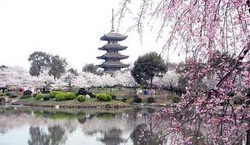 Yuyuantan Park, totaling 137 hectares (338.5 acres), is located on Xisanhuan Road (Xisanhuan Lu), in Haidian District. The park boasts extensive waters and beautiful gardens. Half the footprint is occupied by four lakes: the East and West lakes, the gourd-shaped Bayi Lake and Yinshui Lake. As early as the Liao Dynasty (916-1125), this area had become an imperial fishing spot. The northwest Cherry Blossom Garden, Yinshui Lake Scenic Area in the northeast, Zhongshan Isle in the south and the southeast Liuchun (Keeping Spring) Garden are the main scenic spots.
As its name suggests, the Cherry Blossom Garden is noted for its fascinating cherry blossoms. Today, with thousands of cherry trees sent from Japan and other parts of China, the garden is one of the largest in northern China. Every year, the Cherry Blossom Festival is held from March to April, drawing thousands of visitors. A waterside pavilion offers visitors a place to relax in the Chinese way: chatting while having a cup of tea and listening to birdsong.
|










 RSS Feed
RSS Feed